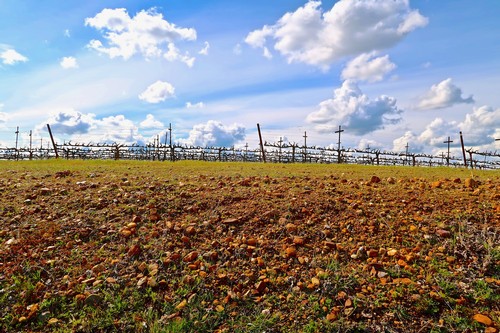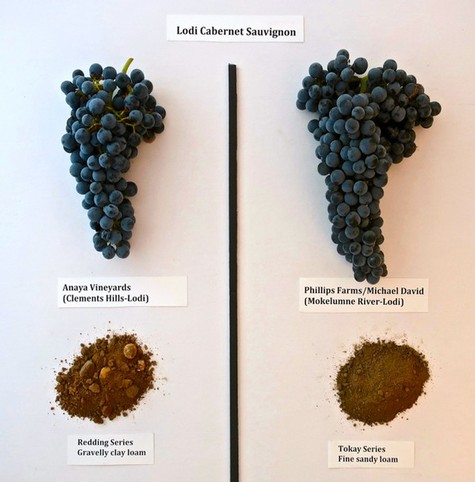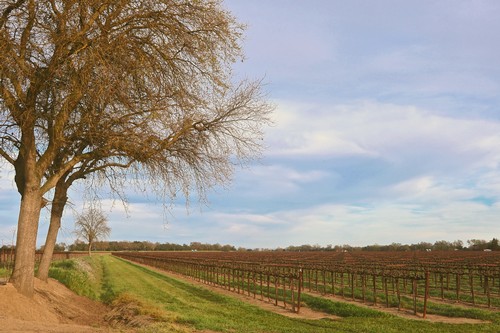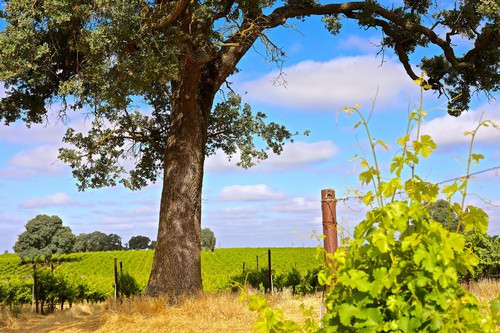Letters from Lodi
An insightful and objective look at viticulture and winemaking from the Lodi
Appellation and the growers and vintners behind these crafts. Told from the
perspective of multi-award winning wine journalist, Randy Caparoso.
What is Lodi terroir? (Part 3, Soil and topography)

Ultra-fine and deep (as much as 100-ft.) Tokay sandy loam soil giving definition to Lodi's Mokelumne River Viticultural Area.
Continued from What is Lodi terroir? (Part 2, Mediterranean climate)
In August 2006, the TTB (Alcohol and Tobacco Tax and Trade Bureau) approved the usage of seven new American Viticultural Areas (a.k.a. AVAs) falling within the broader Lodi AVA (originally recognized in 1986):
• Alta Mesa
• Borden Ranch
• Clements Hills
• Cosumnes River
• Jahant
• Mokelumne River
• Sloughhouse

The Lodi AVA with its seven nested AVAs, sandwiched by the Delta to the west, the Sierra Nevada foothills to the east, Sacramento to the north and Stockton to the south.
Here is the skinny: The entire Lodi AVA can be defined by pretty much the same Mediterranean climate. Temperatures, and diurnal swings, barely vary north to south, east to west, throughout the appellation's entire 551,000 acres.
What, then, was the justification for sub-dividing into seven sub-AVAs, or "nested" appellations? Short answer: Soil and topography, which also have substantial impact on grape growing, cluster morphology and, by extension, resulting wines.

The Storie Index submitted in the petition for Lodi sub-AVAs approved by the TTB in 2006, rating the fertility of the various predominant soils—from the highest vigor soils (Mokelumne River's fine sandy loam) to the lowest (the rocky clay soils of Borden Ranch, Clements Hills and Sloughhouse).
Like that of any other wine region in the world with nested appellations, these differentiations among Lodi's sub-AVAs are complex. Although these are generalizations with the usual exceptions and myriad sub-series, for the most part Lodi soils can be broken down into three major soil types:
Tokay Series—deep sandy loam (found in Mokelumne River AVA)
Redding Series—gravelly or cobbled clay soils (Clements Hills, Borden Ranch and Sloughhouse AVAs)
San Joaquin Series—sandy clay loam with shallow hardpan (Jahant, Cosumnes River and Alta Mesa AVAs)

Predominant soils serving as the primary differentiating factors distinguishing the seven Lodi AVAs.
Soil vigor of the contrasting soils has a direct impact on grape cluster morphology and, ultimately, resulting wines. In the Storie Index cited in the 2005 petition submitted to the TTB to establish Lodi's seven nested AVAs, the soil vigor of the Jahant, Cosumnes River and Alta Mesa areas were rated in the 24-40 range—considerably less vigorous than the soil in Mokelumne River (rated 80-95), but more vigorous than the hillside areas of Clements Hills, Borden Ranch and Sloughhouse (rated 15-30).
So let us dive deeper into the terroirs of the individual Lodi appellations in terms of the three predominant soil differentiations...
Tokay Sandy Loam Soil (Mokelumne River AVA)
The historic farmlands surrounding the City of Lodi are largely less than 100-ft. above sea level, situated between the lower foothills of the Sierra Nevada mountain range to the east, and the lower elevation, freshwater marshland of the Sacramento-San Joaquin River Delta and Carquinez Strait to the immediate west. The far western edge of the Lodi AVA is below sea level, falling in the Delta area.
The Carquinez Strait connects Suisun Bay (where the Sacramento and San Joaquin Rivers flowing down from Sierra Nevada meet) with San Pablo Bay (the northern extension of San Francisco Bay). The entire Sacramento-San Joaquin River Delta dates back approximately 10,000 years, when seismic activity drained the inland sea that covered the entire San Joaquin Valley (geologically, stretching over 400 miles from present-day Redding in Northern California's Shasta County to Bakersfield in Kern County) into the Pacific Ocean. With most of its elevation lying at least 15-ft. below sea level, the Delta area is the only break in the entire California Coast Ranges—hence, exerting a huge impact on the climate of the farmlands surrounding the City of Lodi that are directly adjoining.

Contrasting soils and topography: (Top-left) the flat sandy loam of Mokelumne River; (bottom-left) the rocky clay hillsides of Borden Ranch; (right) the shallow sandy clay loam of Jahant.
By the time the nested AVA of Mokelumne River was officially recognized in 2006, the agricultural land surrounding Lodi had been known for well over a century for its deep, rich, fine, talcum powder-like alluvial soil—as much as 90-100-ft. deep—classified as Tokay sandy loam. This fertile valley soil is complimented by the same dry Mediterranean climate, and warm seasonal temperatures and diurnal shifts, typifying most of the California coast between Santa Barbara and Sonoma.
In fact, most American AVAs are not defined by nearly as much of a consistency of topography (10 to 85-ft. elevation flats, with less than 2% slopes) and single soil type as the Mokelumne River appellation surrounding the City of Lodi. Whereas most American wine regions consist of a multiplicity of soils, slopes and elevations, in the Mokelumne River AVA there are no steep mountains or significant hills, and no rocks or even gravel: Just this well drained mix of decomposed granite (derived from the base rock of the Sierra Nevada, eroded away by constant river action) and sediment washed down from the mountains, starting in the Miocene period (some 20 million years ago) when the San Joaquin Valley was still an inland sea, although most of the soil farmed in the Mokelumne River appellation today is less than 25,000 years old.

Woodbridge Irrigation canal running through Mokelumne River AVA vineyards, including, on the right, the ancient vine Bechthold Vineyard (own-rooted Cinsaut planted in 1886).
Just a few feet below the surface of the valley floor in the vicinity of the Mokelumne River is an enormous aquifer of water, which made early farming of a succession of major crops in this rich sandy loam that much easier, although winter flooding prior to the 1963 completion of the Camanche Dam and Mokelumne River reservoir, east of Lodi, was not uncommon.
Redding Clay Soils (Clements Hills, Borden Ranch and Sloughhouse AVAs)
In significant contrast to Mokelumne River is Clements Hills, located just east of the City of Lodi and the tiny one-saloon town of Victor. As you drive into this appellation even a casual observer notices how the topography suddenly transitions from flat ground into rolling hills of 150 to 400-ft. elevation. Soils become a visibly red (or yellowish red) clay loam of volcanic origin, which are gravelly or cobbled, and less vigorous on the hilltops; notwithstanding tiny pockets of sandy-clay-loam closer to where the Mokelumne River winds through the hills (particularly along CA Hwy. 88 between the towns of Lockeford and Clements).
The favorable resemblance of these soils to much of California's North Coast was not lost to Lodi growers such as Keith Watts, Bokisch Vineyards' Markus Bokisch, Delicato Family Wines' Indelicato family, John and Ralph Graffigna, Kevin Delu, Round Valley Ranches' Jonathan Wetmore as well as Brad and Randy Lange of LangeTwins Family when they first began planting wine grapes in these hilly areas in the late 1980s and '90s.

Rocky Redding clay soil typifying most of Lodi's Borden Ranch AVA.
In respect to red wines, such as high-demand Cabernet Sauvignon, clay soils offer potential for deeper (in terms of color, aromas and flavors), more densely phenolic (i.e., tannin and other sensations contributing to mouth-feel) styles of wine—in distinct contrast to the more gentle, flowery styles of wine that tend to be produced in the fine sandy loam soils of Lodi's historic Mokelumne River AVA.
Delicato Family Wines Vineyard Manager Bud Bradley has described these hilly, lower elevation appellations along the eastern edge of the broader Lodi AVA as Sierra Nevada "toehills." Besides distinctive soil series, these foothill-type terroirs are also characterized by a subtle variation of the Mediterranean climate defining the Lodi in general.
Markus Bokisch has also cited slight differences in diurnal temperature patterns. In an Appellation America interview Bokisch has explained: “... the warm days concentrate the flavors of the wines and serve to balance the tannin. Another characteristic that is often overlooked is that the Clements Hills enjoy some of the coolest nights of any Lodi AVA, which allows the grapes to retain their acidity and also provides further balance to the robust tannic and flavor profiles.”

Demonstration of the impact of soil and topography on grape cluster morphology: On left, Cabernet Sauvignon grown in lower vigor gravelly clay loam in Lodi's Clements Hills; versus (on right) Cabernet Sauvignon grown on higher vigor fine sandy loam in the flatter topography of Lodi's Mokelumne River AVA.
Consequently, much of the growth of the Lodi winegrowing industry—consisting of about 42,000 acres of planted wine grapes in 1986 when the Lodi AVA was officially recognized, shooting up to over 100,000 acres by 2016—has been in the east side Lodi appellations of Clements Hills, Borden Ranch and Sloughhouse.
San Joaquin Series Soils (Jahant, Cosumnes River and Alta Mesa AVAs)
The distinguishing common denominator shared by the Jahant, Cosumnes River and Alta Mesa AVAs—sandwiched between the Sacramento-San Joaquin River Delta to the west and the lower foothill appellations of Clements Hills, Borden Ranch and Sloughhouse to the east—is their variations of the official California state soil (since 1997) classified in the San Joaquin series. San Joaquin soils are characteristic of the lower elevation (generally below 100-ft.), terraced, shallow-topsoil, floodplain topography predominant in much of Northern San Joaquin Valley and Sacramento Valley.
In this soil series, the surface layer is commonly a reddish to yellowish brown, partial sand/clay loam 2 to 6-(at the most)-feet in depth, formed above a cemented clay or sandstone hardpan that restricts root and water penetration. While very useful for irrigated crops such as wheat, rice, fruit and nut orchards and ranching, historically these areas were not as favored for deeper rooted grape crops as the Mokelumne River area surrounding the City of Lodi with its far deeper (as much as 90-feet), more porous and vigorous alluvial sandy loam, falling in the Tokay series.

Den Hartog Vineyard in Lodi's Jahant AVA.
The transition between the deep sandy loams of the Mokelumne River AVA and the shallower loams of the Jahant AVA has always been traced by Peltier Rd. running east-west, north of the City of Lodi, and north of the winding Mokelumne River where it crosses W. Peltier Rd. between N. Davis and N. Lower Sacramento Roads.
Starting in the 1980s, longtime Lodi farming families such as the Langes and Schatz, plus newer arrivals like Netherlands-born Pieter den Hartog, began to make use of deep ripping equipment to break up hardpans and plant wine grapes extensively. This enabled them to establish deeper loam surfaces of increased vigor, mixed with finer textured subsoils just above and below the hardpans to increase a clay content that is particularly ideal for the formation of phenolic content important to the quality of high-demand varieties such as Cabernet Sauvignon and Merlot.
Our next Lodi Wine post: What is Lodi terroir? (Part 4, Where to find terroir-focused Lodi wines)

Blue oak—a species of Quercus that thrives in shallow hillside soils—in Lodi's Clements Hills AVA.